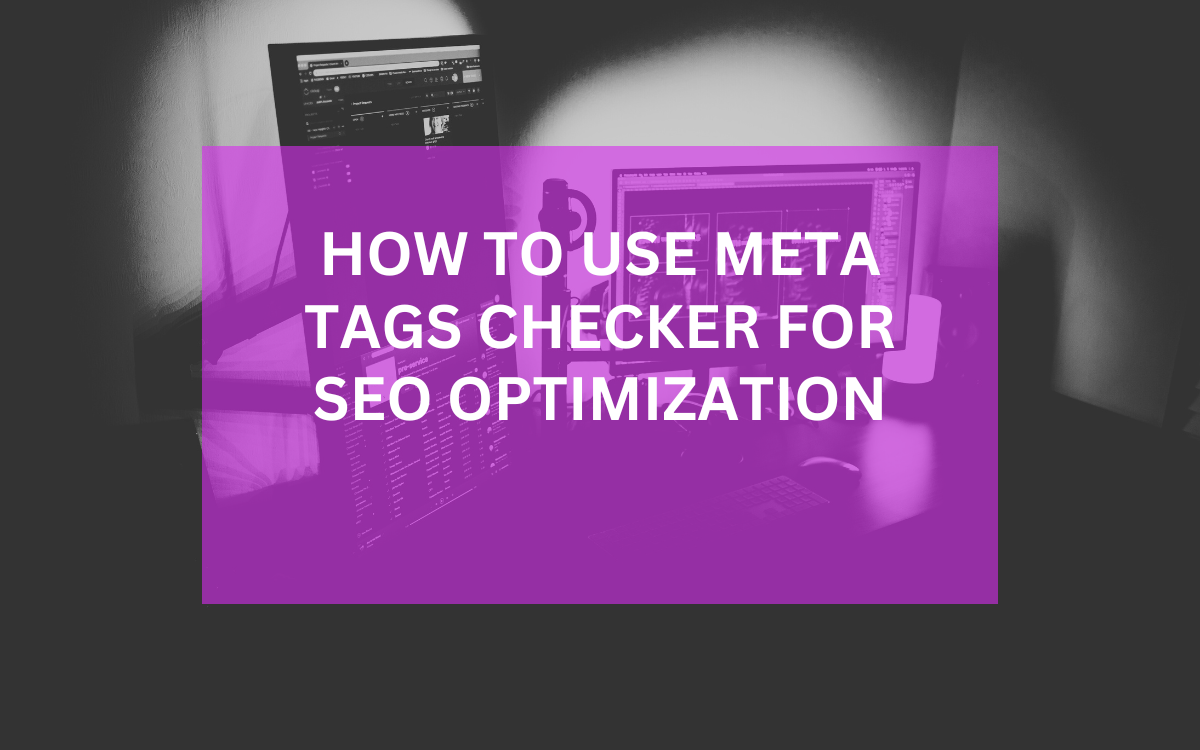How to Use Meta Tags Checker for SEO Optimization
Created on 24 September, 2024 | Checker tools | 29 views | 4 minutes read

Optimize your SEO strategy using a meta tags checker for better visibility and performance in search results.
In the ever-evolving world of digital marketing, optimizing your website for search engines is crucial. One of the most effective methods to enhance your site's visibility is through the use of a meta tags checker. By understanding and implementing meta tags properly, you can significantly improve your SEO strategy. This article will delve into the importance of meta tags, how to use a meta tags checker, and the impact of these elements on your website’s search engine performance.
What Are Meta Tags and Why Are They Important for SEO?
Understanding Meta Tags
Meta tags are snippets of text that describe a webpage’s content. They do not appear on the page itself but are part of the HTML code. They provide information about the webpage to search engines and web browsers, helping them understand the page’s purpose.
Importance of Meta Tags in SEO
The significance of meta tags cannot be overstated. They help search engines index your site more effectively, which can lead to higher rankings in search results. For instance, the meta title and meta description can influence click-through rates, which are vital for driving traffic to your site. As a result, optimizing these tags is essential for any successful SEO strategy.
How to Use a Meta Tags Checker Effectively
Choosing the Right Meta Tags Checker
Selecting an appropriate meta tags checker is the first step. Numerous online tools are available, but it’s essential to choose one that offers comprehensive features. A good checker should provide insights into various elements, including:
- Meta title
- Meta description
- Meta keywords
- Header tags
By using a reliable meta tags checker, you can ensure that all essential tags are optimized for search engines.
Analyzing Your Website’s Meta Tags
Once you have selected a meta tags checker, the next step is to analyze your website's existing meta tags. Here’s how to do it effectively:
- Enter Your URL: Most meta tags checkers require you to input your website's URL. This action will pull up all relevant meta information.
- Review the Results: After running the analysis, review the output. Look for any missing or poorly optimized meta tags.
- Identify Areas for Improvement: Take note of any discrepancies or issues that need addressing. For example, if your meta description is too long or too short, you can adjust it accordingly.
Optimizing Meta Tags for Better Performance
After identifying areas for improvement, it's time to optimize your meta tags. Here are some critical factors to consider:
Crafting Effective Meta Titles
Your meta title is crucial for both SEO and user experience. It should accurately reflect the content of the page while incorporating primary keywords. Keep these tips in mind:
- Length Matters: Aim for a title length of 50-60 characters to ensure it displays correctly in search results.
- Use Actionable Language: Create a sense of urgency or curiosity. For example, instead of “Learn SEO,” try “Master SEO Techniques Today!”
Writing Compelling Meta Descriptions
A well-crafted meta description can entice users to click on your link. Here’s how to write an effective one:
- Length: Keep it between 150-160 characters to avoid truncation in search results.
- Include Keywords: Naturally integrate your primary keywords to improve relevance.
- Call to Action: Encourage users to take action, like “Discover More!” or “Get Started Today!”
Utilizing Meta Keywords Wisely
Although many search engines, like Google, no longer use meta keywords for ranking, it’s still wise to include them for smaller search engines. Consider these points:
- Relevance: Ensure that the keywords you select are relevant to your page’s content.
- Avoid Overstuffing: Don’t cram too many keywords; focus on 3-5 relevant ones to maintain quality.
Monitoring Your Meta Tags’ Performance
Regularly Reviewing Meta Tags
After optimizing your meta tags, the work isn’t over. Regularly monitoring their performance is crucial for ongoing SEO success. Here’s how to keep track:
- Use Analytics Tools: Tools like Google Analytics can help you track how well your pages perform in search results.
- Check Click-Through Rates (CTR): Evaluate your CTR for pages with optimized meta tags. A low CTR indicates that further adjustments may be necessary.
Adapting to Changes in SEO Best Practices
SEO is not static; it evolves continuously. Staying updated with the latest trends is essential. Here’s what you can do:
- Follow Industry Blogs: Websites like Moz and Search Engine Journal offer valuable insights into SEO trends.
- Participate in Forums: Engage with communities on platforms like Reddit or Quora to learn from others’ experiences and strategies.
Conclusion: Enhancing Your SEO Strategy with a Meta Tags Checker
In summary, using a meta tags checker is a fundamental step in optimizing your website for search engines. By understanding what meta tags are and how to use them effectively, you can significantly enhance your SEO efforts. Regularly review and optimize your meta tags, stay informed about industry changes, and watch as your website climbs the search engine rankings.
]
Additional Resources:
Popular posts
-
Top 10 AI Tools Everyone Should Know About in 2024!
AI Tools | 221 views
-
20 Free AI Tools That Are Making People Rich
AI Tools | 163 views
-
26 Best YouTube to MP3 Converting Tools For 2024!
YouTube Tools | 144 views
-
Understanding Facial Recognition: Impacts and Ethics
AI Tools | 107 views
-
Inside Transformers: The AI Powerhouse Behind GPT, BERT, and T5
AI Tools | 102 views